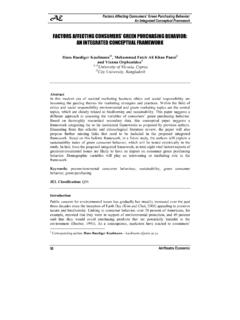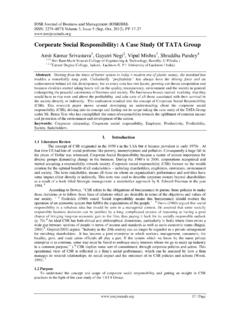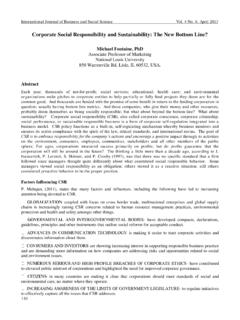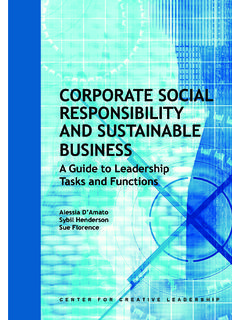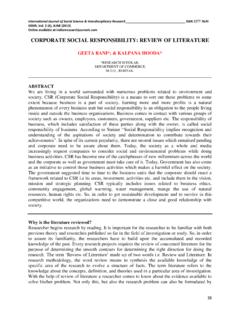Transcription of RESEARCH ON CORPORATE SOCIAL …
1 CORPORATE SOCIAL responsibility AE Vol. XIII No. 29 February 2011 117 RESEARCH ON CORPORATE SOCIAL responsibility REPORTING Camelia I. Lungu1 , Chira a Caraiani2 and Cornelia Dasc lu3 1) 2) 3) The Bucharest Academy of Economic Studies, Romania Abstract The paper aims to revisit the relationship between reporting companies characteristics and the importance assigned to SOCIAL and environmental disclosure, using statistical correlations. We conducted a content analysis on the extent of sustainability reports of the largest 50 companies classified by Global Fortune in 2009, in order to address the RESEARCH hypotheses. Results show that size characteristics measured by assets and revenues cannot be correlated to the extent of CORPORATE SOCIAL responsibility reports published by companies, but there is a significant negative correlation between change in revenues and return on equity and SOCIAL and environmental disclosure for the sampled companies.
2 Keywords: CORPORATE SOCIAL responsibility ; SOCIAL and environmental reporting; companies characteristics; statistical correlations JEL Classification: Q56 Introduction In the last years, the call for increased SOCIAL responsibility , by governments, investors and corporations, was distinctive and urgent due to the global crises that took a central role. Financial market breakdowns, severe economic declines and food shortages required immediate responses. It seemed that climate change finally received due attention, with growing recognition of critical consequences without a significant change in the course. More and more entities are using CORPORATE non-financial reporting, encompassing the SOCIAL , environmental and economic impact of the company s operations, not just as an accountability tool but to drive strategy, unlocking new sources of revenue and growth.
3 Companies are not turning to sustainability for altruistic reasons. Profitability and growth are at the heart of their reasons for building sustainability tools into their business strategy. When people make decisions about the natural resources usage they must take into consideration the processes which are used to get these resources, and who has access to them. The next generations will still have enough resources and the environment will be left, as you know it today or even better in order to be normal living conditions? For these questions, the decision makers should find answers (Bodea, et al., 2010). Even since the beginning of 2000 s, the demand for disclosure of most important listed companies has dramatically increased and the failures of large companies listed on the most Corresponding author, Lungu Camelia AE RESEARCH on CORPORATE SOCIAL responsibility Reporting Amfiteatru Economic 118 important stock exchanges have placed extra pressure on them and on standard setters for the increase in the quality of CORPORATE reporting (Beretta and Bozzolan, 2004).
4 During this period, most world companies reported a hard to manage financial environment and many business difficulties. A strong commitment to all areas of sustainability was generally reported, with the emphasis on the fact that sustainability is not a nice-to-have, but an essential component of doing business. Many companies also have board-committees that take responsibility for, and oversee, sustainability on the board's behalf. Most companies, furthermore, complied with a voluntary reporting framework and disclosed adequate adherence to the related principles. As of 2008, there has been an increase in the quality and effectiveness of the SOCIAL and environmental information reported. Mammatt, et al. (2010) assert that there are companies reporting a large volume of data (with a difficulty in identifying relevant information for stakeholders), but, also, companies reporting poor information (with a difficulty in commitment to sustainability).
5 The criticism about SOCIAL and environmental reporting argues about the increasing of CORPORATE SOCIAL responsibility (CSR) and the limited amount of disclosures (Solomon and Lewis, 2002). In other cases some organizations that label themselves, as CORPORATE SOCIAL reporters do not behave in a responsible way concerning sustainability (Moneva, et al., 2006). It is also criticized that organizations often have good intentions in sustainability, but they cannot transform those intentions into actions and results. Expectations about the responsible role of business in society are increasing and the recent RESEARCH on CORPORATE SOCIAL responsibility discourse shows that there have been developments of a variety of instruments that aim to improve, evaluate and communicate socially responsible practices (Golob and Bartlett, 2007).
6 We consider reporting an important communication tool, which can ensure greater CORPORATE transparency and enable a better engagement with stakeholders. This is an exploratory study designed to investigate the extent and nature of SOCIAL and environmental disclosure in CORPORATE SOCIAL reports. The latest studies refer the recent accounting scandals that look different from the perspectives of the political/regulatory process and of the market regarding CORPORATE governance and financial reporting (Ball, 2009). Although researchers referred to a wide range of theoretical perspectives, they have consistently speculated that larger, more profitable firms, and those in more socially and environmentally sensitive industries can be expected to make greater use of the (typically voluntary) disclosure of information about their SOCIAL and environmental activities (Gray, et al.)
7 , 2001). Almost all prior studies of environmental disclosure indicate that the extent of disclosure is significantly related to company s size (Cho and Patten, 2007; Patten, 1992, 2002). Their conclusion was that larger companies tend to disclose SOCIAL and environmental information more extensive. All these aspects support our study on investigating a number of hypotheses in order to establish if CORPORATE attributes as size or profitability can explain a different extent in SOCIAL and environmental reporting. Then, we discuss the results by reference to prior studies conclusions. Our study contributes significantly to RESEARCH in SOCIAL and environmental disclosure by investigating the extent of CSR reports and the companies size and profitability, results that may be used for designing a possible national reporting framework.
8 CORPORATE SOCIAL responsibility AE Vol. XIII No. 29 February 2011 119 In order to respond the RESEARCH questions regarding the sustainability reporting, we conducted content analyse on the extent of CORPORATE SOCIAL responsibility (CSR) report for the first 50 companies on Global Fortune. We, then, tested the correlation between independent variables regarding the size and the profitability of reporting companies and the extent of their CSR reports published for the year 2008 in order to confirm our RESEARCH hypotheses. The paper is organized as follows. An overall introduction is completed by a synthesis of SOCIAL and environmental researchers results on CORPORATE characteristics determinants regarding CORPORATE SOCIAL disclosure. Further, we explain the methodology, including the sample and data collection, the RESEARCH techniques, and the RESEARCH hypotheses.
9 The next section refers to the main results of the content analysis and the correlation analysis. The final part summarizes the main findings of the study with a discussion of implications for future RESEARCH . 1. Determinants of CORPORATE SOCIAL reports extent In order to justify the statistical tests used, we next discuss the nature and potential impact of the main factors driving the disclosure of SOCIAL and environmental information by companies. Over the time, researchers had different points of view regarding CORPORATE SOCIAL and environmental disclosure, but one of the most important areas was to explain the correlation between SOCIAL and environmental information and CORPORATE characteristics: size, profitability and/or industry. A great number of studies have investigated the nature and frequency of CORPORATE SOCIAL responsibility disclosures, their patterns and trends, and their general relationships to CORPORATE size and profitability.
10 International comparisons indicate differences between countries and over time in the SOCIAL and environmental disclosure area. Gray, et al. (2001) conducted a study that provides a review of the prior RESEARCH which has explored the relationships between SOCIAL and environmental disclosures and CORPORATE characteristics and concluded that a substantial body of literature assert that SOCIAL and environmental disclosures are an important phenomenon employed by corporations for a variety of purposes, from a wide spectrum of theoretical positions. Increasing environmental performance became a more and more prominent requirement in all fields. Its accomplishment is made within the framework of changes promoted by governmental environmental policies and it is still featured by many uncertainties (Bran, et al.)
